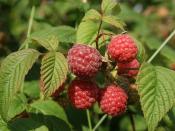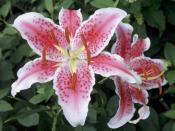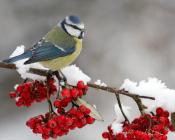Search
Login
Actinidia - varieties, cultivation, reproduction
Lovers of exotic plants will surely enjoy growing a plant such as Actinidia creeper. The birthplace of the plant is Asia, but it became known only after cultivation by an amateur gardener in New Zealand, thanks to him we now know about the delicious fruits of kiwi. The Chinese gooseberry weaves and blooms with beautiful white flowers, which gives it the right, is on a par with ornamental plants. Actinidia is not fastidious in growing, resistant to pests and diseases, the plant feels good in our climate and even pleases gardeners with fruiting. So, fruiting actinidia, planting and care, reproduction and popular varieties.
Content
- Actinidia, description video
- Actinidia, varieties for the suburbs and not only video
- Actinidia, planting and requirements
- Actinidia, growing video
- Actinidia reproduction
Actinidia, description
Actinidia is a woody, fast-growing vine, each stem of which reaches 10 m in length. The leaves of the plant are wide, blooms in early summer with white or cream flowers with a light pleasant aroma. Edible fruits, size and yield depend on the type and variety of lianas, the first fruiting 3 years after planting. The plant is suitable for covering arbors and decorating pergolas.

Actinidia, a dioecious plant, i.e., to obtain fruits, it is necessary to plant two seedlings - female and male. If you want to replace a vineyard with a vine, there must be at least one male seedling for 8 female seedlings. Self-pollinating varieties are known, this choice is convenient for small garden plots, but the fruits of a monoecious actinidia are less tasty.
Actinidia fruits of garden species, of course, differ from dessert kiwi, which is sold in stores, but they are not inferior to the large fruit in taste and vitamin value.
Actinidia, varieties for the suburbs and not only ..
Two types of plants are suitable for a cool climate - acute actinidia and colomict actinidia, they are quite hardy, but they produce fewer fruits than other species less adapted to our climatic conditions.
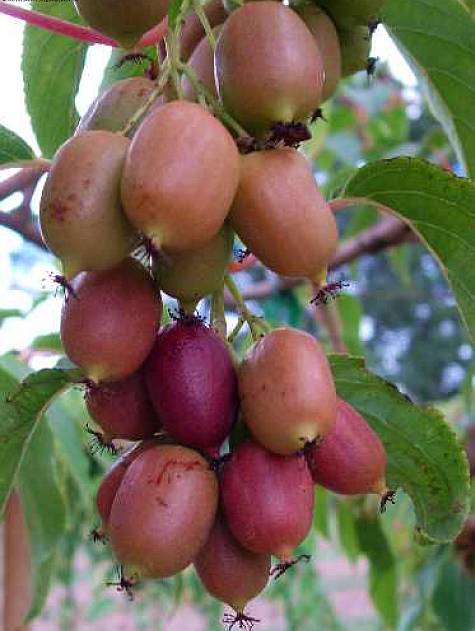
Acute actinidia or actinidia argument, the planting of which is so common in our gardens, reaches 10-15 m in height. Argut green leaves change color to yellow in autumn; in winter, the plant needs shelter. Flowers with a diameter of about 3 cm, male creepers bloom longer.

The fruits of actinidia acutifolia ripen in September-October, 150 sunny days are required for fruit ripening. The fruits are small - only 4 cm in length and 3 cm in volume. The actinidia of the argument is the most productive species, up to 40 kg of fruits can be harvested from the shrub, but this indicator varies depending on the selected variety and growing conditions.

The most frost-resistant varieties of this species are Jumbo and Veiki, the actinidia of the Issai variety is self-pollinating. In our country, other varieties are also known, such as Taiga emerald, Kiev large-fruited.
The length of shoots of the colomict actinidia creeper reaches 5 m, frost resistance is higher than that of acute actinidia (up to -40C). The plant is distinguished by the unusual color of the leaves; pink and green and white colors are present on them. The elongated fruits resemble gooseberries, the weight of kiwi from 1.5 to 4 grams. Fruits ripen in August, harvest before ripening, as the fruits of this species quickly deteriorate, poorly tolerate transportation. Unripe kiwis are stored with apples at room temperature, ethylene secreted by apples will accelerate fruit ripening.

During the first three years of growth, actinidia colomict develops special substances that attract cats, animals like to chew on leaves, stems and even the roots of the plant, after planting, do not forget to protect the vine with a high mesh. The most famous variety of this species is Dr. Shimanovsky, a self-pollinating variety that bears fruit in the 4th year, yield - up to 15 kg from one plant. Also, pineapple and VIR-1 varieties are not deprived of the attention of gardeners.
Actinidia, planting and requirements
The southern corner of your garden, the warmest and sunniest, will help actinidia survive the frost, fertile, well-drained soil with a pH of 5 to 6.5 will provide the plant with all the necessary minerals.
Planting is carried out in the spring after the end of the frost, seedlings are purchased at the age of 2-3 years, the place for planting is enriched with organic matter, for example compost. Seedlings can be planted along the fence, pergolas or near a tree trunk, with independent cultivation, provide the plant with support with a height of at least 1.5 meters.

Actinidia completely replaces the vineyard and bears fruit for more than 50 years, assuming this variant of planting, install support posts with steel vertical wire at a height of 1.8 m. Bushes are planted in the spring at a distance of 2.5 m from each other and 50 cm from the support. Do not save on planting male actinidia, as good pollination is one of the main factors affecting the quality of the fruit.
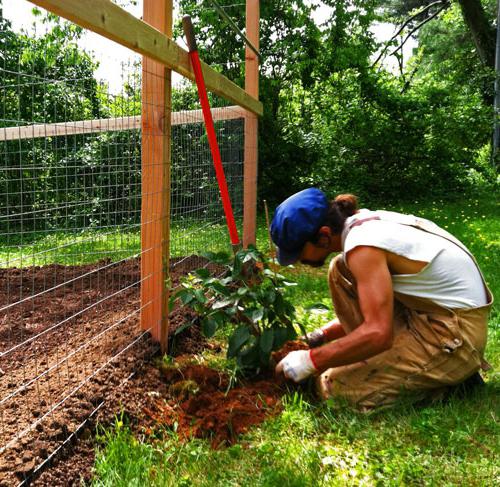
As the young shoots grow, they turn around the support pillar, if the plant is planted along the wall, horizontal wire is also needed here as a support for the vine. Young shoots are very flexible and eventually become stiff, if you miss this moment it will be difficult to wrap branches around the support.
Actinidia, growing
The first two years, seedlings of all types need shelter for the winter, in subsequent years, shelter is recommended only in case of severe frost. Lianas are very sensitive to drought, and in the absence of rain, actinidia is affected by spider mites, so do not forget to regularly water the plants.
Starting from the second year after planting, nitrogen fertilizers are applied - about 30 grams of nitrogen for one shrub, this dose must be divided into three equal parts and the application should be distributed from April to June. The older the plant, the more nitrogen it needs, so we increase its access to 150 g in the fifth year of growth.

Trimming actinidia is not required if the plant is planted for a single decorative purpose, if you want to get a crop, you will need some knowledge. Pruning of fruit-bearing actinidia is not only about removing dry shoots, in the second year after planting, each shoot is reduced by 8-10 buds, after each fruit collection, fruit-bearing branches are removed.
Actinidia reproduction
Actinia propagated by cuttings and seeds. Cuttings are prepared in winter and stored until spring. In spring, the cuttings are planted in a substrate, the container with the future seedling is set in a place well lit by the sun, the cuttings are covered and watered. When the first three leaves appear, actinidia is opened and taken out into the street, in August the seedling is ready for transplanting.
Sowing actinidia seeds is possible in spring or autumn, before sowing the seeds are kept in hot water for 24 hours. Planting depth is about 1 cm, the soil is covered with perlite or sand on top. The container with seeds is placed in a warm and bright room where the temperature does not drop below 25C. The substrate must always be moist, the seeds germinate up to 3 months.

The seedlings obtained from the seeds will be heterosexual, it will be possible to clarify the female or male plant only during the first flowering, unfortunately, the actinidia from the seeds blooms only after 8-10 years.

